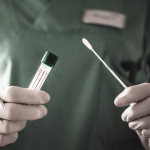Long-term treatment with a topical immune-stimulating cream called Aldara (imiquimod), approved for the treatment of external genital warts, may also improve or clear high-grade lesions inside the anuses of men living with HIV and may potentially reduce the risk of cancer. This is the conclusion of a study published online August 19 in the journal AIDS.
While the prevalence of nearly all AIDS-related cancers has been considerably reduced since in the introduction of potent combination antiretroviral (ARV) therapy in 1995, some non-AIDS-related cancers are now on the rise. Many are caused by viral infections—liver cancer from hepatitis C virus (HCV), non-Hodgkin’s lymphoma from Epstein-Barr virus (EBV) and anal cancer from human papillomavirus (HPV).
Experts believe that HPV progression to anal cancer begins with precancerous growths, notably high-grade intraepithelial lesions (HSIL). However, HSIL can remit spontaneously, albeit infrequently, and it can sometimes take many years for HSIL to progress. As a result, it is difficult to predict whether, or how quickly, HSIL might progress to anal cancer.
Unfortunately, options for treating HSIL are limited and haven’t yet been proved to reduce the chance of developing cancer. Still, treatment—either ablation (burning away lesions) or surgical excision of the lesions—is is generally recommended.
These procedures, however, can be painful and cause lasting complications. Moreover, anal lesions frequently return after treatment in HIV-positive people. This leaves people with HIV, and their providers, in a frustrating situation. When should treatment be offered and under what circumstances? And how should a recurrence be treated?
There may be another, less invasive, alternative to burning away lesions, however: Aldara. The cream, which stimulates the production of HPV-fighting immune cells, has been used successfully, and is currently approved, to minimize external warts. Few studies, however, have tested whether it might also treat HSIL within the anus.
Peter Fox, MD, from the Chelsea and Westminster Hospital and NHS Trust, in London, and his colleagues, set out to test this theory and compared Aldara with a placebo in HIV-positive men who have sex with men (MSM) who were confirmed to have HSIL.
The study was originally designed to include 120 men. Fox and his colleagues, however were unable to obtain more Aldara for unspecified reasons midway through the study, leaving them with only 53 study participants: 28 on Aldara and 25 on placebo. The men were randomized to treat themselves at home, by rubbing in half of an Aldara packet no deeper than 2 centimeters into the anus three times per week for four months. High-resolution anoscopy and biopsies were used to confirm the presence of HSIL at study entry, at the end of treatment and then in regular intervals up to one year following the end of treatment. Men who failed to respond to the initial round of treatment and those who initially received a placebo were invited into a follow-on study involving four months of Aldara treatment.
Aldara proved quite effective. When including all of the men—both those originally randomized to Aldara treatment and those who used the drug in the second round of treatment—Fox’s team found that 61 percent of the men on Aldara showed sustained absence of HSIL. Comparatively, only one person taking the placebo in the original four months of study saw his HSIL resolve. Side effects were generally mild, and only one participant stopped taking the treatment due to side effects.
“This study demonstrates the effectiveness of imiquimod for the treatment of [anal canal intraepithelial lesions], and the benefit of prolonged or repeated treatments,” the authors comment. “This form of therapy is likely to be especially valuable for patients with widespread multifocal [lesions] who are otherwise difficult to treat, and should be considered as an adjunct to ablative therapy.
“It is true that we cannot yet prove that these interventions will prevent anal cancer, but we at least know that [high-grade lesions] can be cured,” the authors continued. “This is certainly not going to prevent all anal cancers, but it would be a grave error to await the outcome of long-term natural history studies. Although much more research is needed, the time has come for all HIV [centers] to begin screening for and treating [anal lesions].”
Advertisement
Advertisement
Advertisement






3 Comments
3 Comments